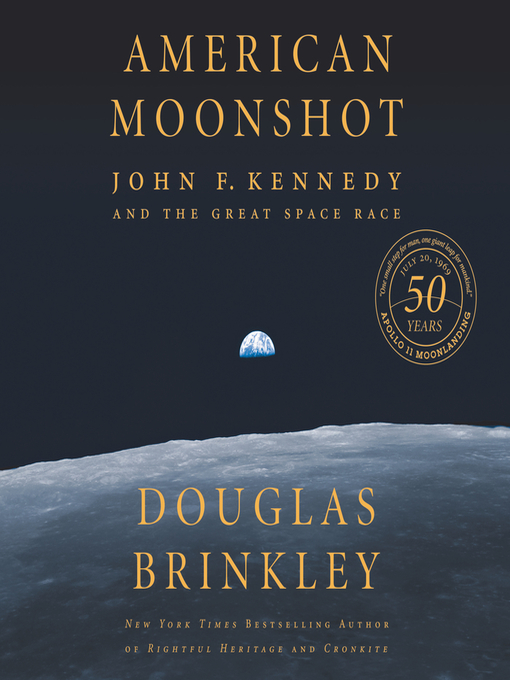By Thomas Oliphant
https://www.washingtonpost.com/outlook/inside-kennedys-quest-to-put-america-on-the-moon/2019/04/04/6bd26cac-499c-11e9-93d0-64dbcf38ba41_story.html?utm_term=.10a38ab017aa
April 4, 2019

During the 1960 presidential campaign, a Princeton University freshman wrote to candidate John Kennedy seeking his views on the future of America’s space program. The Soviet Union had the lead in the space race, having launched the first satellite, Sputnik 1, in 1957, and continued to push ahead. In his reply to the student, Kennedy wrote of the “possibilities of leap-frogging the Russians,” adding that “without leap-frogging I fear we shall be getting their exhaust in our face for quite a long time.”
When Kennedy became president, he “articulated a visionary strategy to leapfrog” the Soviets to assert space leadership, writes Douglas Brinkley in his new book, “American Moonshot: John F. Kennedy and the Great Space Race.” “Sometimes in history,” Brinkley explains, “a single word or concept can trigger a blinding flash that illuminates a presidency or the life of the nation. ‘Leapfrog’ . . . became that kind of word, taking on a life of its own in NASA culture.”
When Kennedy took office, America was cautiously moving toward manned flight in increments, always a step or two behind the Soviet Union; by the time he was assassinated, the country had committed irrevocably to go to the moon and was at work on a crash program to do it. With a mixture of granular detail from a gigantic body of works on the subject and analyses of Kennedy’s decision-making and political savvy, “American Moonshot” transcends mere narrative to help the rest of us understand how America geared up for the astonishing feat of landing a man on the moon. With the approach of the 50th anniversary of Neil Armstrong’s “small step for man,” Brinkley’s focus on the all-important early days provides a valuable perspective.
Brinkley deftly shows the tense atmosphere that surrounded Kennedy’s special message to Congress on May 25, 1961, calling for a widening commitment to the space program. In the previous month, Soviet cosmonaut Yuri Gagarin became the first man to orbit the Earth. The United States had hoped to send astronaut Alan Shepard into space months before Gagarin, a launch that would have earned America the glory of the first manned spaceflight. But Shepard’s liftoff was delayed repeatedly. Gagarin’s interceding accomplishment was another setback for the American program, prompting Kennedy to pepper his advisers with urgent questions: “Is there any place we can catch them? What can we do? Can we go around the moon before them? Can we put a man on the moon before them? . . . Can we leapfrog?”
A few days after the Soviets’ success in space, the United States suffered a political and public relations disaster when the Cubans routed the CIA-sponsored Bay of Pigs invasion. In anticipation of Kennedy’s special message to Congress, the press speculated that the president would deliver “a comeback address, redirecting [his] high-minded optimism and undeniable energy after the double wallop of Yuri Gagarin and the Bay of Pigs,” Brinkley writes.
And Kennedy lived up to expectations. As Brinkley recounts, “The president laid out the grand challenge that would come to define his administration and legacy.” Kennedy told Congress, “I believe this nation should commit itself to achieving the goal, before the decade is out, of landing a man on the moon and returning him safely to Earth.”
Despite the high ambitions, a policy didn’t exist yet. Kennedy had a decent foundation of American accomplishment and specific plans to build on, but the nation’s future in space was far from certain. Under Dwight Eisenhower’s administration, the United States suffered an embarrassing failed launch of a satellite — the rocket exploded on live television. In the 1950s, the United States succeeded in sending some satellites into orbit. But after his term, Eisenhower was steadfast in his adherence to a cautious program and never hid his disdain for expensive crash programs like Kennedy’s that were designed to advertise America’s might. As Brinkley writes, “Former president Eisenhower continued to snipe that ‘anybody who would spend $40 billion in a race to the moon for national prestige is nuts.’ ”
When Kennedy took office, he had only a transition report that recommended continuing the Eisenhower incrementalism. While Kennedy had bigger ideas, the best estimate of the experts was that the United States could get to the moon by the mid-1970s. But Kennedy never wavered after his decision, as this compelling and comprehensive book shows in depth.
In his epilogue, Brinkley recounts the drama of the Apollo 11 landing on the moon in July 1969, nearly six years after Kennedy’s death. On that day America beat the Soviets by delivering the first two men to the lunar surface. “At around that time,” Brinkley writes, “an unknown citizen had left a lovely bouquet of flowers on Kennedy’s Arlington grave with a thoughtful card that read simply: ‘Mr. President, the Eagle has landed.’ ”
Thomas Oliphant, a retired Boston Globe columnist, is the author with Curtis Wilkie of “The Road to Camelot, Inside JFKs Five-Year Campaign.”
No comments:
Post a Comment